Page 1 of 2
Camera Ignition
Posted: Wed Sep 13, 2006 8:12 pm
by OwThatsMyEye
My friends and i used to make ghetto ass stunguns out of cameras by desodering the flash bulb thing and putting wires in it's place which would stick out of the side of the camera. they you stick it into somone and click the button and it delivers a very painfull shock. So i was wondering if it would be posible to use a disposible camera as a sparker insted of a normal gill starter or stun gun. do you think this would work?
Posted: Wed Sep 13, 2006 8:19 pm
by schmanman
yep, It has been done. It works.
Posted: Wed Sep 13, 2006 8:26 pm
by Atlantis
Mine uses it. I did'nt unsoder it though, I ripped it off with pliers. Hard to get the spark gap right, I just let them rub against each other, so yeah.....
Posted: Thu Sep 28, 2006 7:55 am
by Pwnany
I know this thread is old but I think that the spark would be great for spud-guns! Just look at this, I charged up the capasitor and touched the posative and negative to this metal ruler. Look at these pictures.
Before.

0.08 seconds later.
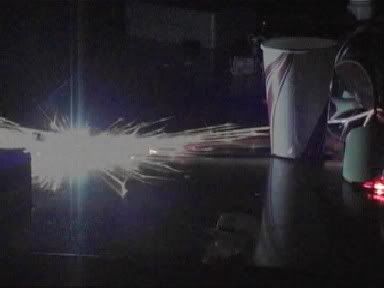
Very bright and hot. It burns little dents into the ruler. But the spark wont jump because its too low in voltage. Still very usable.
Posted: Thu Sep 28, 2006 3:03 pm
by POS
is this a flash light from a camera ?
Posted: Thu Sep 28, 2006 4:31 pm
by carlbelcher
I charged up the capasitor and touched the posative and negative to this metal ruler.
You "touched" the ruler... that means you didn't get an open-air spark.
What are you going to do stick you hand in the chamber and touch the wires together to fire your cannon?
Posted: Thu Sep 28, 2006 8:24 pm
by Pwnany
Does it have to be an open air spark? I don't think it does. It just means you will need to make the trigger a bit more complicated. Here's my diagram.
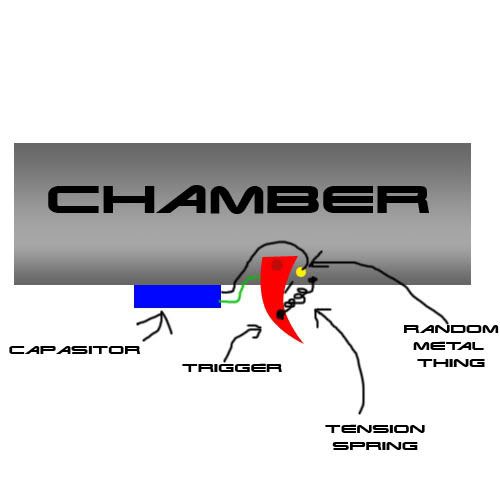
I hope it makes sense. Ohh and the black thing between the trigger and the chamber is a bolt or something like that just to stop the trigger being pulled back to far by the tension spring. The darker red bit on the trigger is the pivot-point. It the 2 things coming from the capacitor are the positive and negative.
When you pull the trigger it will touch the random metal thing. (the yellow circle) and well.... BOOM
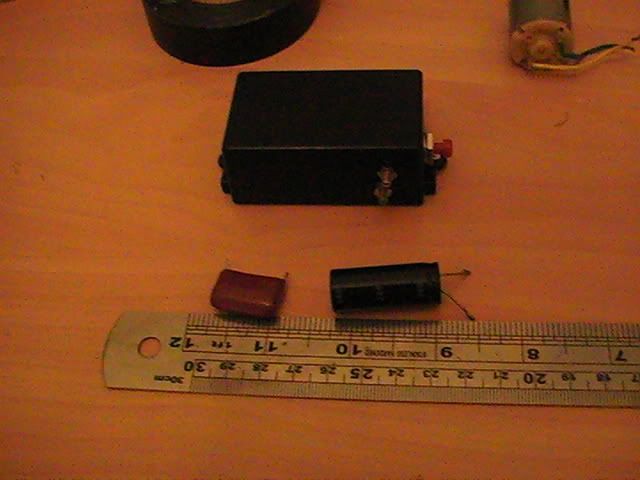
That's how big the capacitor is. (The cylinder one) and the black box behind it is what I use to charge it. It took the transformer out of the camera and put it in the box with a battery and a button. Those 2 bolts you can see are the positive and negative. Its fun to give to people and say the button is really clicky. Hee hee. Its like 350 volts I think. (The charger not the capacitor. I have no idea how many volts that is.
Posted: Thu Sep 28, 2006 9:23 pm
by FiveseveN
Reminding you about the countless other threads on the same topic:
http://www.spudfiles.com/forums/viewtop ... 731㖣
And now, for this particular one:
I have actually made a contact trigger system in an attempt to use capacitor discharge as an ignition source. It was something like this:
+ and - indicate polarity, but that doesn't really matter
|-------- is a nail
( and ) are the ignition chamber's walls
==== is a shaft in which one of the nails can travel
### is a spring that returns the mobile nail to its initial position
So, basically, take two nails, one fixed and one mobile, and wire them to the cap(s). The mobile one should slide nicely in its shaft so it just touches the other one when pressed. Remember to use insulation and your brain. And the friggin spell check

.
I tried it with three of those caps in parallel and couldn't get it to ignite. Then again, my charger wasn't exactly appropriate for the job.
Posted: Sun Nov 05, 2006 2:19 am
by wipsomass
i found that the disposable camera ignition system was really dodge and only worked for 6 times then you needed to adjust the sparkers closer. I think that your much better sticking with a BBQ igniter then this unreliable system.
Also it takes 3-4sec to charge up the cap. which makes it a pain if the cannon didnt fire first time.
Posted: Sun Nov 05, 2006 7:00 am
by Hotwired
Piezo ingiters generate 16,000v+
Flash capacitors are 330v (more or less)
I could go and rummage about in my desk to work out the exact distances but basically 330v needs to be bloody close to jump.
We're talking milimetres or less.
I managed to get a continual arc going once on a 330v capacitor charging circuit, a wire had unsoldered itself veeeerry slightly and was creating a tiny arc about half a mm long.
....which is kinda pathetic for ignition.
Even using the small kilovolt capacitor on the camera circuit to ionise the air between the main capacitor terminals you can only get about a 5mm spark in the open.
Then theres the fact that it needs batteries to run, a circuit to be rigged up and a vague knowledge of electronics.
Piezos give you a couple of centimetres of spark with no hassle
Posted: Wed Nov 08, 2006 6:21 am
by zeigs spud
carlbelcher wrote:I charged up the capasitor and touched the posative and negative to this metal ruler.
You "touched" the ruler... that means you didn't get an open-air spark.
What are you going to do stick you hand in the chamber and touch the wires together to fire your cannon?
soooo...? you don't alwasy have to have an open air soark o light a cannon up. research the camera taser and u'll c theres plenty enough sparks to light the fuel in a cannon.
Posted: Wed Nov 08, 2006 11:12 am
by Hotwired
That camera taser is bullshit.
The voltage from the charging circuit is ~200v+ and that goes up to about 300v when charging a capacitor.
I can't believe someone said it puts out 7000v.
The spark is very short range (<1mm).
...however once I finish hacking the camera circuit I'm working on I'm hoping for 60kv with incredibly low current

Posted: Fri Nov 10, 2006 11:48 pm
by zeigs spud
Hotwired wrote:That camera taser is bullshit.
The voltage from the charging circuit is ~200v+ and that goes up to about 300v when charging a capacitor.
I can't believe someone said it puts out 7000v.
The spark is very short range (<1mm).
...however once I finish hacking the camera circuit I'm working on I'm hoping for 60kv with incredibly low current

watch the language lol god....anywho it's not...ur must really suck cuz i can get a spark of just under half a foot from mine. wht r u using for wiring? Use copper wire if u use anything els it can slow it up.
Posted: Sat Nov 11, 2006 7:15 am
by Hotwired
The flash from the spark can be quite big yes, I'm talking about how far it can jump and 300v does not jump very far.
In fact the easiest way of getting a spark is to manually touch the contacts.
Oh and the camera circuit hacking is going badly. The voltage it normally puts out is 200v AC (rectified to DC) (which still charges a capacitor to 300v) and I've only managed to bump that up to 300v AC/DC.
Hmm...
Posted: Sun Nov 12, 2006 1:43 am
by Killjoy
u guys are right using camera flash circiuts can be a little tricky, but they have been the most reliable ignition source for me. after three years of fooling around, i figured out how to make a almost fall proof ignition setup.
the way the flash works is that a small capacitor discharges into a hv transformer which ionizes the air in the flash to tube making the air resistance almost zero, which then alows the larger capacitor to disharge and create the flash. so basically all you have to do is replace the flash tube with a spark gap, like this one.
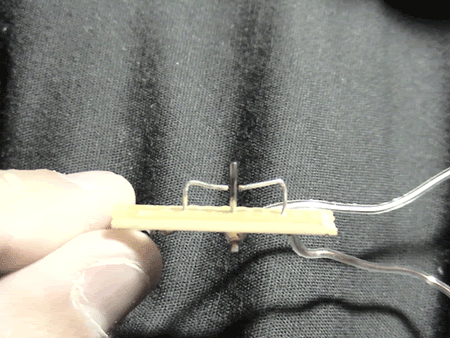
the wire in the middle is connected to HV transformer and the other to bent wires are conneted to the leads of the capacitor. so when you discharge the small capacitor it will go into the HV trans and this will result in the air be ionized beteewn the center wire and the two bent ones which then allows the large capacitor to discharge. the gap between the bent wires and middle wire has to be very small but it will still result in a discharge of the capacitor and ignition.
heres a pick of a camera flash circuit bored i have (I fried it though)
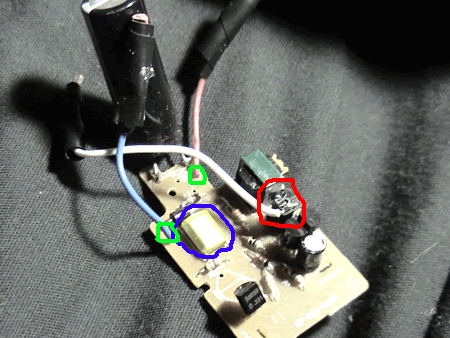
the trans circlued in red is the hv trans which you should connect to the middle wire on the spark gap. the wires circuled in green connect to the main flash capacitor and should be connected to the bent wires separatly.
the cap ciculed in blue is the samll capacitor that discharges into the hv trans. the switch to trigger the smal cap to discharge is on the back of the bored.
since all boreds are dif, before ripping out the circuit bored figure out how it works while its still in the camera, and then mess withit.
hope this helps
[/img]





